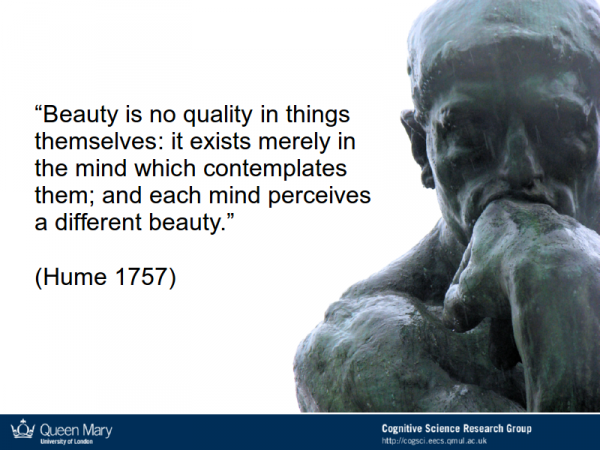For the International Conference on Conversation Analysis 2014 I gave a talk on some work derived from my PhD: Respecifying Aesthetics. It looked at two forms of silent contemplation – and two sequential positions for bringing off silences as accountable moments for subjective contemplation and aesthetic judgement.
The talk looked at where this conventional notion of aesthetic judgment as an internal, ineffable phenomenon might come from in practical terms. In philosophical terms the idea comes from Kant, who gets it from Hume, who draws on Shaftesbury. I think Hume puts it best.

But this talk isn’t about philosophical aesthetics – it’s about the practical production of contemplation in interaction. It points to the kinds of practical phenomena that we can observe in people’s interactional behaviors that might have inspired philosophers to hypothesise that aesthetic judgments are ineffable, internal, psychological activities.
The empirical crux points to two positions in sequences of talk that people can use to present something as arising from contemplation. The first is done as an initial noticing or assessment, launched from first position without reference to prior talk or action. The second is produced as a subsequent noticing – launched in first position as though responsive to some tacit prior ‘first’.
By studying the practical structure of these ostensibly internal, ineffable events, we can develop more plausible hypotheses about how aesthetic experiences function in theoretical or psychological terms.
References
- Coulter, J., & Parsons, E. (1990). The praxiology of perception: Visual orientations and practical action. Inquiry, 33(3).
- Eriksson, M. (2009). Referring as interaction: On the interplay between linguistic and bodily practices. Journal of Pragmatics, 41(2), 240–262. doi:10.1016/j.pragma.2008.10.011
- Goodwin, C. (1996). Transparent vision. In E. A. Schegloff & S. A. Thompson (Eds.), Interaction and Grammar (pp. 370–404). Cambridge: Cambridge University Press.
- Goodwin, C., & Goodwin, M. (1987). Concurrent Operations on Talk: Notes on the Interactive Organization of Assesments. Papers in Pragmatics, 1(1).
- Goffman, E. (1981). Forms of Talk. Philadelphia: University of Pennsylvania Press.
- Heath, C., & vom Lehn, D. (2001). Configuring exhibits. The interactional production of experience in museums and galleries. In H. Knoblauch & H. Kotthoff (Eds.), Verbal Art across Cultures. The aesthetics and proto-aestehtics of communication (pp. 281–297). Tübingen: Gunter Narr Verlag.
- Heritage, J. (2012). Epistemics in Action: Action Formation and Territories of Knowledge. Research on Language & Social Interaction, 45(1), 1–29.
- Heritage, J., & Raymond, G. (2005). The Terms of Agreement: Indexing Epistemic Authority and Subordination in Talk-in-Interaction. Social Psychology Quarterly, 68(1), 15–38.
- Kamio, A. (1997). Territory of information. J. Benjamins Publishing Company.
- Leder, H. (2013). Next steps in neuroaesthetics: Which processes and processing stages to study? Psychology of Aesthetics, Creativity, and the Arts, 7(1), 27–37.
- Pomerantz, A. (1984). Agreeing and disagreeing with assessments: Some features of preferred/dispreferred turn shapes. In J. M. Atkinson & J. Heritage (Eds.), Structures of social action: Studies in Conversation Analysis (pp. 57–102). Cambridge: Cambridge University Press.
- Schegloff, E. A. (1996). Some Practices for Referring to Persons in Talk-in-Interaction: A Partial Sketch of a Systematics. In B. Fox (Ed.), Studies in Anaphora (pp. 437–85). Amsterdam: John Benjamins Publishing Company.
- Schegloff, E. A. (2007). Sequence organization in interaction: Volume 1: A primer in conversation analysis. Cambridge: Cambridge Univ Press.
- Schegloff, E. A., & Sacks, H. (1973). Opening up closings. Semiotica, 8(4), 289–327.
- Stivers, T., & Rossano, F. (2010). Mobilizing Response. Research on Language & Social Interaction, 43(1), 3–31.
- Vom Lehn, D. (2013). Withdrawing from exhibits: The interactional organisation of museum visits. In P. Haddington, L. Mondada, & M. Nevile (Eds.), Interaction and Mobility. Language and the Body in Motion (pp. 1–35). Berlin: De Gruyter.